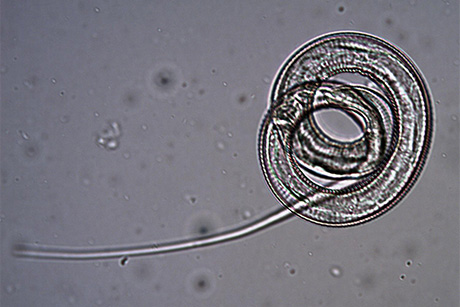New worm infecting U.S. cats discovered
By Carly Hodes

When Cornell veterinarians found half-foot-long worms living in their feline patients, they had discovered something new: The worms, Dracunculus insignis, had never before been seen in cats.
Published in the February issue of the Journal of Feline Medicine and Surgery, the findings document the first proof that this raccoon parasite can infect cats.
The female D. insignis worm can grow to be almost a foot long and must emerge from its host to lay eggs that hatch into larvae. It forms a blister-like protrusion in an extremity, such as a leg, from which it slowly emerges over the course of days to deposit its young into the water. When Dr. Jennifer Pongratz ’99 found one of the female worms in a Massachusetts cat and Dr. Sara Sanders ’98 found several in a New York cat, they sent samples to Cornell’s Animal Health Diagnostic Center and the lab of Professor of Parasitology Dwight Bowman; both suspected Dracunculus.
“The problem is you can’t tell the exact species by looking at female worms,” said Dr. Araceli Lucio-Forster, a researcher in Bowman’s lab and the paper’s lead author. “You need males to tell the species, because only they have distinct characteristics, such as different shapes of tail protrusions, to tell one from another.”
Bowman’s lab collaborated with Dracunculus experts at the Centers for Disease Control to study sections of the worms in detail and conduct molecular analyses to confirm the identification.
Worms in the Dracunculus genus are well-known in human medicine. D. insignis’ sister worm, the waterborne Guinea worm (Dracunculus medinensis), infected millions of humans around the world until eradication efforts beginning in the 1980s removed it from all but four countries with only 148 cases reported in 2013. Other Dracunculus worms infect a host of other mammals – D. insignis mainly infects raccoons and other wild mammals and, in rare cases, dogs. It does not infect humans.
“The cats that contracted the worms likely ingested the parasites by drinking unfiltered water or hunting frogs,” said Lucio-Forster.
It takes a year from the time a mammal ingests the worm until the females are ready to migrate to an extremity and start the cycle anew.
While the worms do little direct harm beyond creating shallow ulcers in the skin, secondary infections and painful inflammatory responses may result from the worm’s emergence from the host. There are no drugs to treat a D. insignis infection – the worms must be removed surgically.
“Although rare in cats, this worm may be common in wildlife and the only way to protect animals from it is to keep them from drinking unfiltered water and from hunting – in other words, keep them indoors,” said Lucio-Forster.
The study, “First Report of Dracunculus Insignis in Two Naturally Infected Cats from the Northeastern USA,” received no outside funding.
Carly Hodes ’10, MBA ’15, is a communications specialist at the College of Veterinary Medicine.
Media Contact
Get Cornell news delivered right to your inbox.
Subscribe